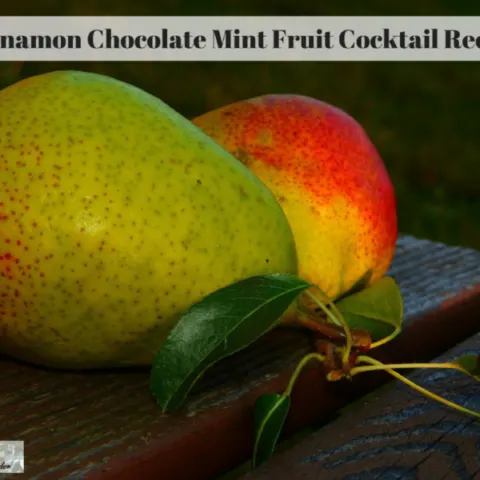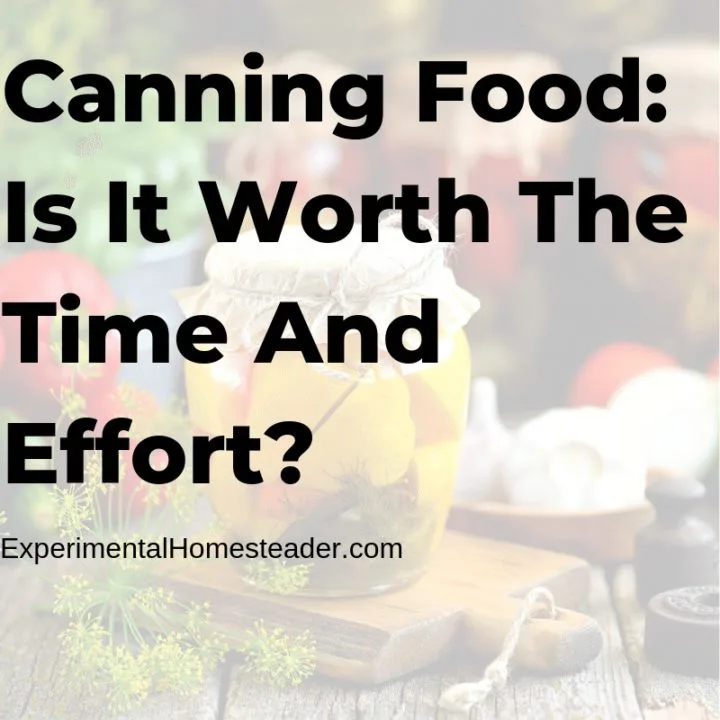Stocking up on food that you preserved is a great way to save money and eat healthier which is why understanding your home food preservation options is so important.
Let's face it, I don't know what all those preservatives are in the foods I buy are, do you?
I'm not even sure after talking to my local grocer if I can trust any of the signs they put up stating the food is local grown.
This is why home food preservation and growing my own food is so important to me - and it should be important to you too.
Local Grown Covers The Entire State
So I asked the produce manager at our local grocery store about the local grown sign and how to get produce from my farm into the store.
I always thought local grown meant it was grown somewhere in the county you lived in - boy was I wrong!
Local grown means it came from somewhere in the state, was shipped in a semi-truck from the farm to the stores processing center where it was processed according to their standards, then shipped to the actual grocery stores and put on their shelves.
That seems like a lot of wasted gas, a lot of unnecessary processing because the products are handled by the farmer, the shipper, then by the employees of the grocery store, not to mention a lot of wasted time.
True, the products don't come from the other side of the country, but they are still days old when you get them, which means the nutrient value is down.
You have no idea what farm they came from, how the products were grown or what went on them during the processing.
As far as I'm concerned, I'd rather buy straight from a local farmer or better yet, grow my own vegetables, fruits and herbs.
Farmer's Market Produce Isn't Always Local Grown Either
Oh - and if you think all the produce at farmer's markets are grown by the people selling the products, think again.
There are huge auctions where vendors can go and buy what they want then take it to the farmers market and sell it.
Now, I'm not saying all vendors do this or that all markets allow it, I'm just advising that you ask where the produce you buy comes from and if possible, support a real local farmer!
It could mean the difference between their continued survival and the loss of their farm.
Grow Your Own Food For The Best Home Food Preservation Options
When it comes to getting the most bang for your buck and eating as healthy as you can, nothing beats growing your own food.
I don't care if you live in an apartment, there are things you can grow year-round in containers.
Tomatoes for one and best of all, tomatoes are easy to grow.
All you need is a container - a five-gallon bucket works well and many deli's will give you one for free, a grow light and good soil - use compost if you have it, but be aware worms and other critters may be in it, so shift it well.
Be sure to drill some drainage holes in the bottom of the bucket and sit in in a large saucer so water does not run all over your floor when you water it.
That's all there is to it.
You'll be harvesting fresh tomatoes all winter long - and don't worry about pollination.
Tomatoes self-pollinate before the flowers open.
You can grow an entire vegetable garden indoors using this technique if you choose to and have the room.
So don't let lack of space hold you back - get growing - and preserving your own food.
Your Home Food Preservation Options
Once you have all those fresh vegetables, the next step is learning how home food preservation works.
Dehydrating, freezing, canning, freeze drying, preserving in oil or salt are popular home food preservation methods.
Most people end up using a combination of these methods to preserve a wide variety of herbs, meats, vegetables and herbs.
After all, the more food you put up, the more money you will save on your grocery bill.
Dehydrating Is Just One Home Food Preservation Option
Dehydrating is nice because it removes most of the water from the food you are preserving.
This means you can store more food in less space and the packages are very lightweight.
The drawback is when you get ready to use that food, you have to rehydrate it.
This often takes a couple of hours since the food needs to absorb the water and plump back up.
Dehydrated food has a long storage life and either this, or freeze dried food, is the type of food often sold in survival kits.
I dehydrate fruits such as bananas, pears, apples, cherries, cranberries, blueberries and these make great snacks that you don't need to rehydrate.
I also use my dehydrator for herbs, garlic as well as garlic scapes, peppers, tomatoes and edible flowers.
Peppers and tomatoes are wonderful powered and used as a spice.
Canning Is One Of The Most Popular Home Food Preservation Options
Canning is my favorite method of food preservation and many others agree.
It takes a while to prepare the food, prepare the jars and do the actual canning, but when I'm ready to eat what I have preserved, all I have to do is open the jar.
It's like store bought food - only better.
I also control the amount of sugar and salt.
While you do need to put it in there to help preserve the food, let me tell you the small amount you add is nothing compared to what is in store bought food.
The most important thing to remember when you are canning is to keep things clean.
Check the lids 24 hours after processing and periodically throughout the storage process to make sure they are still sealed.
If the lid is loose within the first 24 hours, you can put that food in the refrigerator and eat it up or re-seal the jar using a new lid.
If the lid comes loose while it is in storage, throw that food away.
Don't chance getting sick!
Freezing Is Another Popular Home Food Preservation Option
Freezing has advantages as well.
It's quick and the food is easy to prepare once you remove it from the freezer.
Some foods such as meat or fruit will need thawed, other foods such as vegetables are ok to cook in their frozen state.
Sometimes I wash and quarter tomatoes or other foods that I have a tiny amount of and freeze them.
Once I have enough, I remove them and can them.
This is a great way to save time during the summer too.
The food will keep in the freezer for several months thus allowing you to process it after the busy growing season is over.
Other Home Food Preservation Options
Preserving foods in oil and salt is no longer recommended, but there are books out there that tell you how to do it.
I preserve garlic scapes in salt every year.
I put a thin layer of salt in the bottom of the canning jar, cut the scapes into thin pieces, put a small layer of them on top of the salt and cover them with more salt.
I then alternate salt, garlic scapes, salt until I run out or reach the top of the jar.
The top layer needs to be salt by the way.
You can use the garlic scapes just like you use garlic and use the salt like you would garlic salt.
Another recently popular home food preservation option is freeze drying which works great for milk, eggs as well as left over foods.
A Harvest Right Freeze Dryer is not a cheap investment, but freeze dried food lasts for years as long as it is stored correctly in mylar bags.
I hope this gives you some ideas and gets you on your way to learning home food preservation methods.
As always, I welcome questions and comments.
Canning Food At Home
Packing And Sterilizing Canning Jars
The most important part of canning is packing and sterilizing the canning jars properly. Learn how to do this important step the right way.
The Ultimate List Of Home Canning Recipes
This ultimate list of home canning recipes are all tested and proven to work. Learn how to preserve the fruits and vegetables you grow in your garden!
Canning Broccoli Is No Longer Safe But You Can Still Preserve It
Although canning broccoli was once considered safe, times have changed thus freezing, dehydrating or freee drying broccoli is recommended.
Homemade Beef Stew Recipe For Canning
When it comes to having quick home cooked meals that just need reheated, this beef stew recipe for canning can't be beat!
Red Hot Apple Wedges Canning Recipe
Preserving your own food means trying new recipes, such as this red hot apple wedges canning recipe. While it is true, it is a good idea to stick to recipes you know you and your family will eat, it never hurts to branch out a bit.
Cinnamon Chocolate Mint Fruit Cocktail Recipe
This Cinnamon Chocolate Mint Fruit Cocktail recipe is ideal to use up some of your extra summer fruit or to combine some of the fruit you have already preserved to come up with something a little different.
How To Make Homemade Maraschino Cherries
Learn how easy it is to make and can your own homemade maraschino cherries. Not only do these taste great, but they are easy to preserve too!
Five Spice Cherry Canning Recipe
This five spice cherry canning recipe is a unique take on typical recipes for canning cherries. I love the way the spices complimented the tart cherries!
How To Easily Start Canning Blueberries
Learn how to easily start canning blueberries in your own kitchen. Home canning is a great way to preserve fresh foods that you or someone you know grew.
Apple Canning Recipes
There are many recipes for canning apples and I think I have tried them all. However the best way is to can them in plain syrup.
How To Make Raspberry Vinegar
A great way to preserve raspberries is to make raspberry vinegar. Its delicious on pork chops! Best of all you can preserve it for winter use by canning it.
Orange-Cranberry Vinegar And Marinade Recipe
This orange-cranberry vinegar and marinade recipe is easy to make, easy to can and tastes great!
How To Make Homemade Ketchup
Learn how to make homemade ketchup right in your own kitchen using tomatoes you grew in your garden. This recipe works with fresh or frozen tomatoes!
Homemade BBQ Sauce Recipe
This homemade bbq sauce recipe uses fresh tomatoes and is perfect for canning. Use it as it is or as a base sauce to create different types of BBQ sauces.
How To Make Cajeta Goat Milk Caramel
Learn how easy it is to make cajeta goat milk caramel from fresh goat milk. Plus learn how to preserve it for winter use by canning it.
How To Make Homemade Honey
Learn how to make homemade honey right in your own kitchen using a mixture of water, sugar, red clover, white clover and fireweed!
How To Make Rose Petal Jelly
Learn how to make rose petal jelly using fresh rose petals from your favorite organically grown roses. Try different roses for unique flavored jelly.
Delicious Raspberry-Chocolate Sundae Topper Recipe
This delicious, easy-to-make raspberry-chocolate sundae topper is an ideal canning recipe making it easy to serve to guests or give as gifts!
Try These Off Season Food Preservation Ideas
These off season food preservation ideas are perfect for the off season. There are lots of items you can fill your freezer with or even can year-round.
Importance Of Food Preservation Inventory
Do you understand the importance of food preservation inventory? From spices to food stored in the freezer and pantry, this list can help you save money.
Four Factors That Affect Food Storage
Understanding the four factors that affect food storage is essential for keeping your food safe, especially if you intend to store it long term.
Canning Food: Is It Worth The Time And Effort?
Learn if canning food at home is really worth the time and effort involved as well as about some of the supplies you need to get started.
Home Canning Supplies
There are a number of home canning supplies you need to get started canning food at home, the Bellemain Kit contains 6 of them.
Canning At Home
When canning at home making sure everything is clean and in good condition is essential for food safety and your families health.
Fruit Juice Concentrate
Learn how to make your own fruit juice concentrate at home using fresh fruits from your garden or the farmers market.
Preserving Citrus Fruits
Preserving citrus fruits is something you want to know how to do if you grow your own, buy in bulk or have citrus fruits given to you.
Preparing Fresh Green Beans
Get out of the grocery store and into home-canning fresh green beans. Experience the symbiotic relationship of land and food security.






































